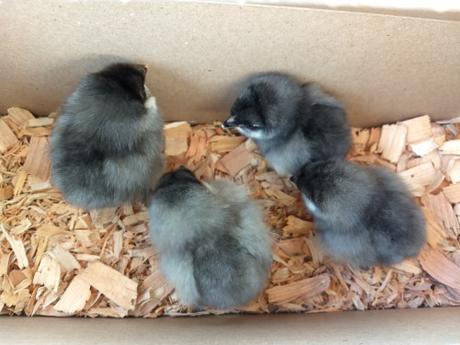When I heard the chicks had arrived at our local Tractor Supply store, I pulled my chick gear out ofthe storage closet and got everything ready, including running everything through the dishwasher to be sure it was completely sanitary. Unfortunately, I found for the second year in a row that this store never carries very many varieties of pullets; last year it was only hybrid leghorns and Ameraucanas, and this year Ameraucanas and a breed I was unfamiliar with, Sapphire Gem. But they’re attractive birds and the advertising says they’re good layers (average 290 eggs/year), and the most important thing is to have hens that are easily distinguished from last year’s so I can tell the generations apart once these are full grown (next year I’ll probably get some Rhode Island Reds or a similar breed). For the next three weeks, I’ll be able to enjoy their silly antics as they run around their enclosure in the bathroom; it’s the best place to start them because we keep the door closed, thereby protecting them from the cats and dogs. We also keep a small radiator on low in there, so it’s the warmest room in the house. At three weeks we’ll move them to a caged area inside the henhouse until they’re ten weeks old; for the last four weeks of that period they get to roam around the chicken yard in the daytime and are shut in at night to protect them from being pecked to death by the adult hens. Over the years, I’ve found this strategy works best; it lets the adult hens get used to their smell and presence before being able to get near them, and that results in fewer lost chicks. It’s a shame they’re only cute for such a short time, but once they’re grown up it’s worth the minimal effort needed to keep them for the deliciousness of fresh eggs.

